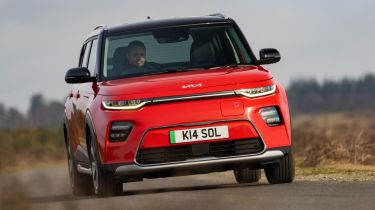Kia Soul EV review: performance, motor & drive
The Kia Soul EV is better to drive than you might expect, with punchy acceleration and a clever regenerative braking system
| Model | 0-62mph | Top speed | Driven wheels | Power |
|---|---|---|---|---|
| 39kWh | 9.9s | 97mph | Front | 134bhp |
| 64kWh | 7.9s | 104mph | Front | 201bhp |
The Kia Soul EV is now offered with two powertrains, and entry-level Urban models feature a less powerful 134bhp electric motor. We've yet to try this base model, but have tested a 201bhp version of the electric family SUV. That power output means acceleration is brisk and the car builds speed seamlessly, characteristics matched with easily-judged proportions and advanced safety aids to make it a great city car. But while it makes light work of town roads it's also well suited to faster A-road, dual-carriageway and motorway driving. It’s a stable-feeling car that’s easy to drive, and will satisfy as long as you’re not expecting an overtly sporty feeling.
Kia Soul EV electric motor, 0-62mph and acceleration
The Soul EV isn’t a car you’d naturally expect to feel almost hot-hatchback fast, but with the instant, seamless delivery of electric power and up to 201bhp to play with, it really will surprise much sportier cars away from the line. More importantly, it’s very easy to judge and modulate the build-up of power thanks to decent control and pedal weights, making the Soul EV feel stable and easy to drive.
There are four driving modes to choose from. Normal and Sport have noticeably sharper throttle response and also automatically reduce the regenerative braking force, while Eco is a happy medium with softer settings and slightly extended driving range, but still with a sprightly feel to it.
Eco+ is for full-on hyper-efficiency, with no air-conditioning and greatly neutered power; it’s not much fun, but it's worth having if you do want (or need) to prioritise range above all else. The regenerative braking system has three levels of aggression, as well as an ‘automatic’ setting that uses the car’s radar to automatically maintain distance from the vehicle in front when you come off the throttle, which allows the system to harvest energy rather than using the brake pedal.
It’s worth mentioning that the Kia’s standard adaptive cruise control and lane-keeping assistance are some of the most effective systems on the market; they function together to offer a semi-autonomous driving mode that works well on multi-lane roads.
Handling
Despite the Explore model’s 201bhp electric motor offering zingy acceleration, no version of the Soul EV can be considered a sports SUV. While the Soul offers reasonably tight body control on a twisty road – surprisingly so for such a tall and boxy car – as well as direct steering, the latter never offers much in the way of feedback, encouraging you to proceed at a relaxed pace, rather than pushing on hard.
And that's exactly what most buyers in this family SUV sector are after. Ride comfort is good on the standard 17-inch alloy wheels, but there is a slightly firm edge to proceedings, which is a consequence of the slightly firmer-than-normal suspension needed by almost all electric cars to deal with the weight of the batteries.




